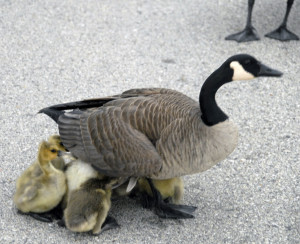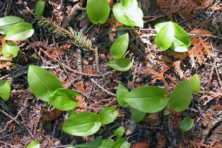Door to Nature: Canada Geese
- Share
- Tweet
- Pin
- Share

Every now and then something quite wonderful happens as I sit staring at my blank paper collecting my thoughts for a story. As usual this week I had scribbled the night before at least two pages of words, ideas and phrases laced with circles or boldly underlined “important” thoughts frequently connected by arrows or squiggly lines, then gone to bed hoping that my subconscious would go to work.
With the first of the Canada Geese heading south, or lingering to rest and feed, I simply had to honor their return as though mysteriously nudged into paying my deepest respects to these magnificent creatures.
I had just finished reviewing my brief notes this morning, giving several key possibilities a numbered sequence, when suddenly there sounded a beautiful honking outpouring right over the house. Racing for the door leading to the upstairs deck I hurried for a look, completely forgetting about the gas grill outside the door and consequently nearly breaking my fool neck!
The flock of about 40 “honkers” was so low that my bumbling commotion made them suddenly veer toward the west. As usual I quickly began counting, hoping the total would be a multiple of six. It was the great Aldo Leopold who, with his wildlife management students at University of Wisconsin-Madison, counted many migrating flocks of Canada Geese (not Canadian Geese) during a period of several years and found that they tended to be in flocks of six, or multiples of six.
Even though most of their clutches of eggs can range from four to 10, they average out to five or six. One also can assume a certain percentage of casualties occurs during their precarious period in late summer when all geese are flightless. The thought is that the family size during the fall migration averages six.
In all of the “Vs” of honkers I’ve counted I don’t remember one in which both arms of the “V” had equal numbers of birds. One thought is that the windward side of the “V” tends to be the longer. Young geese, not yet capable of flight, also tend to form a slanting line or “V” when swimming in their parents’ wakes.
There is little doubt that flying in a “V” formation has its benefits. Naturally there is a slipstream of disturbed air formed behind a bird while flying. This can be quite a considerable mass of resistance following a Canada Goose weighing anywhere from seven to 14 pounds and traveling at a speed of up to 40 or 50 miles per hour.
A bird flying directly behind the bird ahead would obviously experience rather difficult flying. Lying slightly to one side enables the goose to make use of the upwelling air and thus conserve a lot of energy. In fact one researcher calculated that by flying in formation, the geese are able to cover about 70 percent more distance than a bird flying by itself.
Canada Geese, in their northerly spring migration, tend to follow quite closely the movement of the 35-degree F. isotherm. Birds in southern Missouri on Feb. 10, for example, will not have reached the James Bay region (southern Hudson Bay) until April 30. I presume that the autumn southerly flight also consists of quite a few resting and feeding stops along the way.
The genus of the Canada Goose is Branta, commonly thought to mean “burnt.” One can assume that the dark brown-black color of the upper parts, neck and head of the goose gives the bird the appearance of being charred.
A honker’s long black neck and head are frequently referred to as a “stocking” while its white chin patch is called the “chin strap.” One reference lists 11 different forms of Canada Geese ranging from the smallest Cackling Goose (minima) of western Alaska to the largest, the Giant Canada Goose, (Maxima). Size decreases northward. Most likely the majority of those we see in eastern Wisconsin are the medium-to-large Branta canadensis, var. interior.
Adults and young are earthbound for nearly one month while the young are attaining their feathers. The adults lose all of their flight and tail feathers simultaneously, thereby rendering the birds flightless. Gradually their entire plumage will be renewed. This is called their post-nuptial molt and is the only molt they will experience during the year. Most other birds have two molts annually, one partial and the other complete.
While driving through a section of the Horicon Marsh in May several years ago we encountered a family of Canada Geese. The female was sitting right in the middle of the road protecting her youngsters under her wings. One head popped up as we approached. Soon she lifted up to reveal eight goslings in her care. They nonchalantly walked off to the water’s edge nearby as we photographed them.
I think it is quite interesting that the young and old are bound together as their flight feathers develop and that, little by little, they take to the air at about the same time until finally they head for the South as a family.
It is believed that Canada Geese mate for life and that, indeed, a lone bird very well may be one that had lost its mate. Francis Kortright, in his excellent book, The Ducks, Geese and Swans of North America, described the Canada Goose as possessing sagacity, wariness, strength and fidelity. What a great combination of qualities!
Aldo Leopold spoke eloquently, too, of the Canada Goose in his A Sand County Almanac (March essay, “The Geese Return”) when he said, “I once knew an educated lady, banded by Phi Beta Kappa, who told me that she had never heard or seen geese that twice a year proclaim the revolving seasons to her well-insulated roof. Is education possibly a process of trading awareness for things of less worth? The goose who trades his is soon a pile of feathers.”
Oh, if people could only be more like the marvelous Canada Goose!
Charlotte Lukes will lead a mushroom foray at Whitefish Dunes State Park on Sept. 12 beginning at 9 am. There is no fee, but each vehicle must have a park sticker for entry. Meet at the Nature Center for an introductory talk before the group heads out to the trail.





